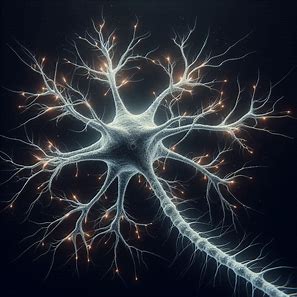Anatomy and Physiology of Neurons
Learn how neurons work, as well as their anatomy. DIY guides on how to grow them in the future!
Cameron
8/11/20252 min read


Intro
Neurons are able to form some of the most complex biological networks known to man. Take a few hundred neurons and they can control a worm capable of instinctive behaviors. With just 1.5 billion neurons, you have a crow with the potential to use rudimentary tools. Take 86 billion neurons however, and you have a sentient human capable of reading, writing, and conscious thought.
Anatomy
Before we get into the more advanced topics, we must first understand what neurons are composed of. First off, neurons can be classified based on function (sensory, motor, and interneurons) and structure (multipolar, bipolar, unipolar). Most neurons are multipolar (99%) but other bipolar and unipolar cells are used as sensory neurons. A neuron starts with a cell body, or soma which contains all the organelles a typical cell needs to survive (e.g. mitchondra, cytoplasm, nucleus). Protruding from the cell body are dendrites. They receive information and there can be anywhere from a few to thousands of dendrites on a neuron. Then, there is another protrusion from the soma called an axon. Axons are slender nerve fibers that transmit information from the axon hillock to the synapses. They can be myelinated or unmyelinated with oligodendrocytes or Shwann cells (In the PNS). The axon terminal and synaptic cleft are where the action potentials are transmitted to another neuron.
Physiology
Let's put this all in context. First, a neuron will receive an electrical impulse or neurotransmitter on it's dendrites. On these dendrites are dendritic spines, which contain synapses. Synaptic vesicles on the presynaptic neuron (neuron sending the message) release neurotransmitters that the synapses on the dendritic spines receive. There are thousands of these dendritic spines on dendrites, which allow for a neuron to receive many different signals. Neurons receive either excitatory or inhibitory neurotransmitters which influence whether it spikes or not. The neuron then takes in the overall spatial inputs, whether excitatory or inhibitory. More inhibitory neurotransmitters like GABA mean hyperpolarization occurs, meaning that the neuron is less likely to fire an action potential. However, more excitatory neurotransmitters mean that at the axon hillock, (the decision point) the neuron can cross the threshold of -55mv causes an action potential. Action potentials occur when sodium ion pumps take in sodium to massively depolarize the neuron, enough to make it go positive 40 mv. This causes a action potential that races down the axon and to the synapses. The action potential initiates neurotransmitters to the next neuron.

Subscribe to newsletter!
Our Youtube Channel is Here ->
TERMS AND CONDITIONS
THIS CONTENT IS ONLY FOR EDUCATIONAL PURPOSES. All information posted is merely for educational and informational purposes. It is not intended as a substitute for professional advice. While the information on this website has been verified to the best of Orr Biological's abilities, we cannot guarantee that there are no mistakes or errors. Should you decide to act upon any information on this website, you do so at your own risk. Under no circumstance shall Orr Biologicals have any liability to you for any loss or damage of any kind incurred as a result of the use of the site or reliance on any information provided on the site.
